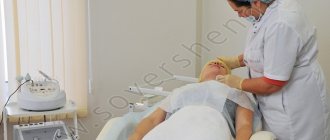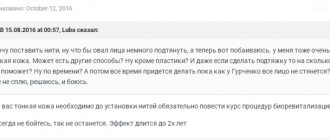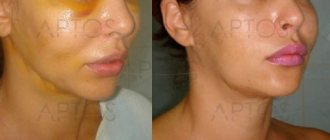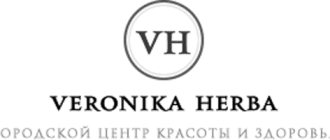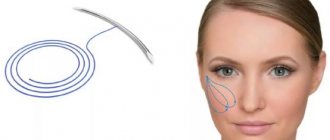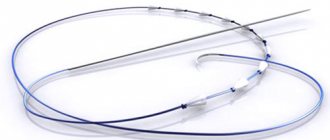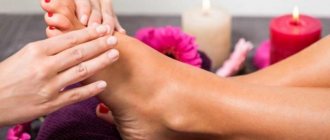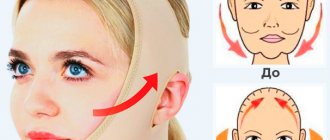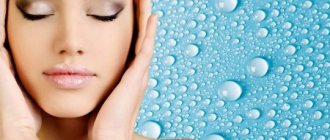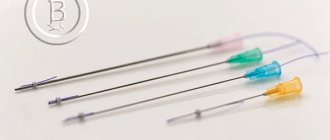One of the most advertised non-surgical facelift methods now is thread lifting. It is described as a safe, gentle, almost discomfort-free procedure for tightening the oval of the face, while its results are quite comparable to the effect of full-fledged plastic surgery. Is it so? Let's try to understand the theory and essence of the technique and what the clinics promise. If you have already read many advertising articles and know everything about the method, but still have doubts, immediately open the end of the article, where - welcome to the real world! — I will tell you about my impressions of this procedure and the experiences of other patients.
PS When I posted the article, I didn’t know that the material would receive such a response from readers who experienced the work (lack of it) of threads on their faces, the consequences of using threads for a facelift. If you are really interested in the opinions of women, then read the truthful reviews of real girls after the post (there are already more than 140 of them!).
A little theory or what advertising says
Facelift with threads is a non-surgical rejuvenation technique. The technique has been known for more than 15 years and is successfully used in various countries around the world. It is advisable to use cosmetic threads in cases where conventional cosmetic procedures no longer provide adequate results in correcting age-related changes. As a rule, this method is chosen by those women who cannot yet decide on serious plastic surgery, and gentle techniques - biorevitalization, mesotherapy, laser resurfacing and the like no longer work.
Types of threads for lifting
The use of threads allows you to tighten the oval of the face, increase skin elasticity, smooth out wrinkles, and make the outline of the face clearer. Depending on the result you want to get, the features of the face and the severity of age-related changes in the patient, cosmetologists and plastic surgeons use different threads for lifting. There are a great many types of these, but the following are most often used.
Smooth (Tissulift)
They consist of intertwined silicone, polyamide and polyurethane fibers. The surface of surgical threads for facelift is smooth, the threads do not undergo biodegradation (resorption). They are placed in the form of a loop in the deep layers of the skin, secured to the bone tissue, so they provide high-quality tightening even with severe sagging tissue. The method involves making incisions under local or, in some cases, general anesthesia, so it is usually performed in an operating room.
Mesothreads (3D mesothreads)
The thinnest of the absorbable face lift threads, they are usually inserted using a blunt cannula, which does not pierce, but pushes the tissue apart. Therefore, the technique is the least traumatic, but requires precision movements and special professionalism from the doctor. Incorrect movements can lead to tightening of the skin and deformation of facial features.
The threads dissolve in the skin after six months, but during this time a collagen framework is created in their place, which provides a supporting effect (this statement only causes a skeptical grin from many doctors) for about two years. But still, the result of their use is the most gentle, so they are not suitable for people with severe age-related changes.
They are used at the first signs of aging or as its prevention - which is more likely to be true - in patients 30–40 years old. It is quite possible to insert mesothreads in a regular beauty salon with a professional cosmetologist, and it is not necessary to contact a plastic surgeon.
Aptos serif threads
Their peculiarity is the presence of barbs, which help the thread to gain a foothold in the tissue, clinging like hooks. The thread is inserted into the subcutaneous layer to a depth of 3–5 mm using a microscopic puncture. Several types of Aptos threads have been developed for lifting different parts of the face (for example, “hammock” threads for correcting a double chin or “spring” threads for the cheeks and nasolabial folds). There are biodegradable threads made from polylactic acid, the effect of which lasts for 2 years, as well as non-degradable threads made of polypropylene, which retain the result for about 4 years.
Rehabilitation lasts about 2 weeks; it is recommended to restrain active facial expressions for a month. As with other types of thread lifting, Aptos threads should only be administered by professionals.
PS My cosmetologist says that she is afraid to use these threads for her patients precisely because of the long time it takes for them to be absorbed inside the body. Like, it’s one thing for the random negative effect of an unsuccessful introduction to last a year, and another for four!
Cone-shaped combined threads (Silhouette Soft)
They have nodules and cones, and thanks to them they are fixed in the tissues in the right places. The base of the thread is made of non-degradable polypropylene, and the knots (usually 8-11 of them) and cones are made of glycolide and lactic acid copolymer, which gradually dissolve, but in their place a capsule of connective tissue is formed, providing a further tightening effect. Used to correct the shape of the face and tighten the skin.
The disadvantages of these threads include tubercles that can protrude in the temple area where the nodules are attached. Recovery takes about two weeks, during which time swelling of the face is observed. For a month, it is not recommended to smile, laugh, or make faces. The cost of this technique varies from 45 to 90 thousand rubles. The price depends on the number of threads used and correction tasks. A facelift is best used by women under the age of 50, since with severe sagging skin, it may not be very effective.
When correction should not be carried out
Unfortunately, this kind of manipulation is not suitable for everyone. There are certain contraindications when blepharoplasty with threads is prohibited, these include:
- ophthalmological diseases;
- oncology;
- problems with blood clotting;
- During pregnancy and breastfeeding;
- diseases of the cardiovascular system;
- problems with the endocrine system;
- tissue tendency to scar;
- slow tissue regeneration;
- diabetes mellitus of any type.
In the presence of chronic diseases, a mandatory consultation with the attending physician and his permission to perform surgical intervention are necessary. Blepharoplasty with threads is not performed if the patient has an inflammatory process at the time of the manipulation.
What are the best threads for face lifting - expert reviews and ratings for 2021
I have collected reviews as of 2022 about the best threads for a facelift according to cosmetologists and plastic surgeons.
In addition to these threads, there are many others, but at the moment, according to reviews, these are the most effective ones.
RESORBLIFT (French manufacturer)
Among the thread options from this manufacturer, the most successful is threads made from 100% polylactic acid. They are believed to provide the most effective biostimulating effect on tissue. But the price of these threads is quite high - 4 threads (1 package) cost around 35,000 rubles.
Another version of these threads for face lifting with notches containing ninety percent polylactic acid costs approximately 25,000 rubles. This is the price for 8 threads of 25 cm per package. Of course, if you have a good budget, experts recommend an option with 100 percent polylactic acid, which has a much better biostimulating effect.
DAR – VIN “ Invisible ” (Italian manufacturer)
Previously, these lifting threads were called SOFTLIFT Invisible. They contain eighty percent polylactic acid. The price of these threads for face lifting is approximately 14,000 rubles for 8 threads of 25 cm, packed together. Can be found at a price of 26,000 rubles per package of 10 threads of 20 cm, each thread is packaged separately.
APTOS Excellence Visage (Russian production)
This type of face lift thread contains seventy-five percent polylactic acid. APTOS threads are considered very high quality among specialists. The package of these threads consists of 10 threads of 19 cm, each contained in an individual cannula.
The disadvantage of threads is their length, which increases their cost.
How is the procedure done?
The procedure is quite painful, so before the operation begins, local conduction or infiltration anesthesia (lidocaine, ultracaine) is used, which is injected into the intended puncture sites. During surgery, threads are inserted using a special needle through a puncture or small incision under the skin. As a rule, the threads have notches or knots, thanks to which it is possible to fix soft tissues and create a new frame, providing the effect of tightening and smoothing the skin.
The operation will take from 20 to 30 minutes. The effect of using threads can be compared to the result of plastic surgery. The rehabilitation period is about 1-2 weeks, in rare cases 1 month. The recovery period depends on the patient’s age, tissue healing, proper care, the qualifications of the specialist and the quality of the correction performed and the threads used, and compliance with hygiene rules. At first, there is swelling of the face and soreness of the soft tissues. Painkillers are prescribed to reduce pain.
Contraindications
While the procedure is safe, you should take into account the circumstances that impede the procedure:
- period of bearing a child, breastfeeding;
- oncological diseases;
- skin tendency to scarring, tissue atrophy;
- an inflammatory process accompanied by an increase in body temperature and general malaise;
- diseases that require correction of sugar levels in the body.
Complications, side effects, results
The results of a facelift using threads last for 1.5-5 years.
Side effects and complications include:
- hematomas;
- swelling;
- painful sensations;
- whitening of the area due to decreased blood supply;
- a knot or notch, the edge of the thread can pierce the skin;
- unnaturalness of the lift (the thread line is visible to the naked eye);
- asymmetry caused by uneven insertion of threads;
- allergic reaction and individual intolerance to anesthesia.
With thread lifting you can achieve the following results:
- reduction of skin sagging;
- smoothing out pronounced wrinkles and folds;
- correction of facial oval;
- slowing down aging.
And now the whole truth about thread lifting
What did you manage to find out about thread lifting, based on your own experience and communication with other patients in the clinic, on forums and just in life?
Reviews from women about the introduction of threads
The procedure is quite painful, in some cases very painful, and under local anesthesia the pain is sometimes almost unbearable. Therefore, many patients choose general anesthesia to perform it; accordingly, they need to take tests and do a cardiogram in advance. This point concerns surgical (golden threads), while ordinary Korean smooth absorbable mesothreads are introduced without anesthesia - if desired, it is quite possible to endure this execution alive, if there are only a few threads.
The face after manipulation usually looks terrible. There is almost always swelling of varying severity, and numerous bruises at the puncture sites. In addition, there are often specific traces of the insertion of threads on the face: recesses of the skin, its folds (gathering), protruding ends of the threads, the threads themselves or rows of tubercles can be visible under the skin.
I was given very few of the thinnest mesothreads in the area around my eyes, the swelling was very noticeable and lasted for three days. After the second injection, which I decided to undergo a month later in the hope of a miracle, my eyes were decorated with two “nice” bruises that went away within two weeks. Considering the fact that I work in a women’s team, I think it’s not difficult to guess what my colleagues were gossiping about.
Rehabilitation
After the introduction of threads, a full rehabilitation period is necessary. It lasts from 2 weeks to a month. In the first days after lifting, as a rule, antibiotics are prescribed, a little later - physiotherapeutic procedures. Swelling, hematomas and puncture marks are clearly visible for 2–3 weeks. (In my case, with smooth mesothreads, no one even mentioned antimicrobial drugs - it healed just like that.)
One of my friends compared the painful sensations to the sensations of a boxer after a fight: it is impossible to touch your face, it hurts to speak and chew, you can only lie down looking at the ceiling, and this lasted for at least 2 weeks. There are many restrictions during rehabilitation: you cannot go to the sauna or gym, drink hot drinks, have a massage, sunbathe, and so on.
Within a month or two, depressions and bumps under the skin, tingling of the threads (sometimes described as “shooting”), bleeding wounds and ulcers in places where the protruding ends of the threads break off are considered normal phenomena. In some patients, areas of the skin located near the area where the threads are installed may lose sensitivity for several days: for example, a “hammock” was installed, and the ear and chin became numb. Quite often there is a feeling of tightness of the skin, a “noose”. The skin may become covered with a crust, which is removed with a scrub after the inflammation has passed.
That is, rehabilitation cannot be called easy and quick. In most cases, returning to a normal lifestyle is problematic. Even in my case, after minimal intervention, I had to wear dark glasses on half my face for several days, although the cosmetologist promised that there would be no marks!
A small digression: girls, never get beauty injections during women's days, a week before and a week after them. Otherwise, even an experienced doctor will not be able to guarantee easy and quick rehabilitation. The second time I inserted mesothreads during menstruation and paid for it with long-lasting bruises.
Thread lift result
The lifting effect is manifested in narrowing pores, slightly increasing skin elasticity, smoothing the oval of the face, reducing nasolabial folds, marionette wrinkles, and tear troughs. The result is usually expressed implicitly and, at best, is assessed by others as “refreshed.”
The number of very small wrinkles under my eyes has decreased slightly, my skin has become more elastic, some sagging has disappeared, but I don’t have even close to smooth “baby skin”.
But what about pictures with magical “before and after” transformations in advertisements for cosmetology clinics? I am inclined to consider them the high-quality work of makeup artists, make-up artists and photographers, or the result of several procedures - for example, mesotherapy and Botox, which were done along with the installation of threads.
The tightening effect usually lasts no more than a year (sometimes even less), even with a successful procedure and the use of non-absorbable threads. If the lifting was unsuccessful...
Rehabilitation after blepharoplasty with threads
How long the body will recover after eyelid correction depends on the individual characteristics of the patient, and on compliance with all the doctor’s recommendations.
Here are the main tips:
- reduce physical activity;
- refuse to visit the bathhouse, sauna, sunbathe or swim;
- sleep only on your back; try not to touch the area around the eyes;
- don't use cosmetics
Try not to show emotions during the recovery period so as not to involve facial expressions. The skin should be cleansed carefully, preferably using antiseptic agents.
Errors and failures of thread lifting
The most harmless of failures can be considered simply the lack of effect. Well, just think, they threw away the money, walked around for a couple of weeks with a swollen, bruised face, and then everything returned to its original form. It’s worse when the face acquires new features that are completely not provided for by nature.
- For example, if the threads shine through the skin when laughing or smiling broadly.
- Or the skin remains gathered, like a fabric into which an elastic band has been inserted.
- Or if one of the hammock threads is so tight that it looks like there is a wire tied around your neck.
- Or - this is, of course, a rare case - when the mesh to which the threads are attached cuts through the skin after some time, forming a permanent inflammation.
Well, almost standard situations: noticeable depressions form on the face; as a result of tightening the nasolabial folds, the mouth stretches like a frog; In the process of correcting a double chin, the skin is tightened and the entire face slides down, forming jowls.
In addition, the influence of the formation of collagen and connective tissue capsules under the skin around the threads (fibrosis) has not been fully studied - it is not clear whether they, for example, interfere with the blood supply or the distribution of nerve endings.
So is it worth doing a thread lift?
As we can see, this procedure is painful, with long and difficult rehabilitation, a little predictable effect, and the cost is quite comparable to real plastic surgery. Its only undoubted advantage is its reversibility, since the threads can always be removed, although in the case of jagged ones this presents certain difficulties.
In a word, I would not recommend this type of lift to anyone, but if you still decide, have it done only by experienced, well-proven plastic surgeons (or licensed cosmetologists in the case of mesothreads) - do not risk your face and health in pursuit of eternal youth.
Don't forget to like and rate the article!
Did you like the article? Subscribe to site updates via RSS, or follow on Twitter, VKontakte, Odnoklassniki, Facebook or Google Plus. And also receive new articles by E-Mail.
Preparing for blepharoplasty
It is better to discuss all the nuances of eyelid correction in detail during a consultation with a cosmetologist. It is important that the patient at the time of the manipulation is absolutely healthy and there is no inflammatory process in the body.
Two weeks before the operation, you should give up bad habits such as alcohol and smoking. You should not take medications that affect blood clotting. If all recommendations are followed, the procedure and rehabilitation will be as painless as possible.
